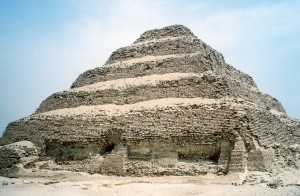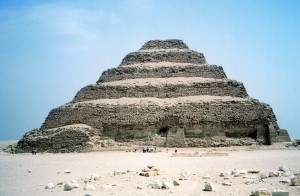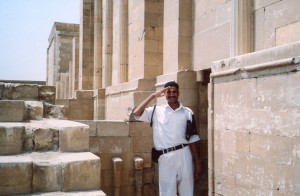Djoser’s step pyramid at Saqqara was one of the most dramatic architectural revolutions in world history. There’s no way to overstate its impact.

Let’s explore what makes Djoser’s step pyramid one of the world’s greatest structures.
1. King Djoser reigned from 2630 to 2611 BCE, in the 3rd Dynasty. His pyramid is more than twice as old as the Roman Forum and the terracotta warriors in China.
2. The pyramid was designed by an architect named Imhotep. He was made into a deity centuries later. It’s easy to see why.
3. It was erected at Saqqara. It’s across the Nile from modern Cairo, and about 15 miles south of Giza. Saqqara might have been the burial ground for pharaohs in the early 2nd Dynasty (which started in 2770)–seal impressions with their names were found within 2 tombs with large sets of underground galleries. Even if the big tombs from that time were only for nobles, Saqqara had already been hallowed before Djoser’s reign.
4. The Step Pyramid was built in 5 stages. It began as a rectangular single-leveled tomb. This was the form that most prior pharaoh’s tombs were in.
5. Then levels were added to the top to make a total of 4.
6. All 4 levels were then extended, and 2 more were added to the top.
7. The Step Pyramid’s total height is 197 feet. This was the first skyscraper.
I found it breathtaking to stand in the sands and gaze up at it under the ebullent sun.
I walked around to the side opposite from the entrance. Gravel was piled up to the top of the first level. Like a little boy, I couldn’t resist climbing. But as soon as I reached the top, a policeman’s voice boomed, “Hello! Close!” I wasn’t going to argue with a guy with a semi-automatic.
But I then walked from that side (the West) to the south side, and looked up. Imagine how awestruck people were 4600 years ago when they marveled at it and had nothing nearly as lofty to compare it to.
But we’ve only seen the surface. In Facts About Kjoser’s Step Pyramid at Saqqara, Egypt; Part Two, we’ll see special things about this monument that most people don’t know about.



{ 1 comment }
This post brought to mind parmyid power, the notion that parmyids possess unusual powers, usually related to preservation of some sort, from keeping foods from spoiling to maintaining the sharpness of razor blades. The latest upswing in the popularity of parmyid power in the United States was in the 1970s. A prime example is the parmyid house in Wadsworth, Illinois, near Chicago. This six-story residence was built in 1977 by Jim and Linda Onan. Now a private residence, the home was open to paying visitors from 1978 to 1981. Sometime during that period, I took a tour of the structure and grounds. It is conceptually and architecturally fascinating.
Comments on this entry are closed.